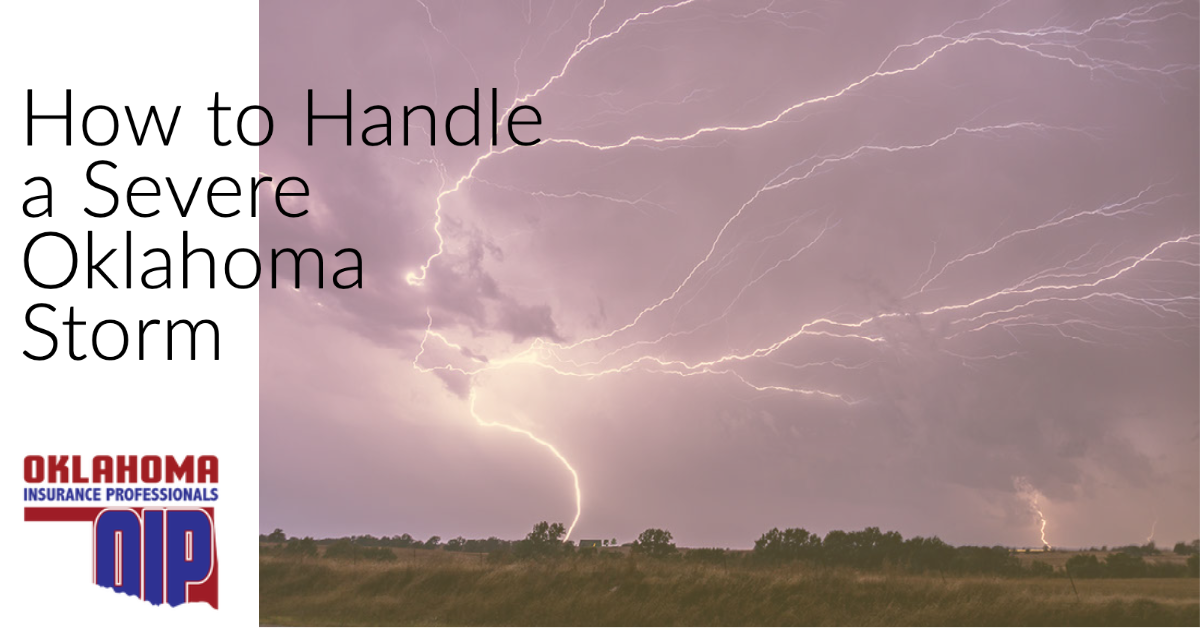Oklahoma Insurance Professionals LLC Blog |
|
It was a rough ride throughout the Sooner state throughout the afternoon and evening yesterday. Severe wind, hail, tornadoes, the threat to modern life conveniences is real, ya'll.Severe storms can be an intimidating natural occurrence that can cause significant damage to property and leave individuals stranded without power or access to resources. Here we are the day after, and I'm reminded, nobody really teaches you what to do about all of this in general. Unless you serve as a first-line responder or work in construction/repair or have an approach to life of survival preparation, you usually get no formal education about how to prepare and recover after a major storm. While books on survival, experts in survival strategies and even those with a doomsday approach exist, what about a natural approach to life that understands emergency situations? After all, a one-size-fits-all survival plan doesn't exist. Here we are a day after some severe storms in Oklahoma once again, and it doesn't hurt to remind of what you should and shouldn't do prior and post-storm. Having a list of ideas and knowing some primitive living skills to help in an emergency situation certain can help your entire family, whatever your familial situation. Being prepared could make all the difference between life and death. What you do after a sever storm could mean the difference in saving money and paying more than you need to. Background of Severe Storms Severe storms are a common occurrence around the world. The frequency of severe storms is variable, depending on the geographic location. Our region in the United States Midwest, experiences frequent tornadoes, hail storms, and severe winds. It's crucial to be aware of the potential hazards of severe storms and to take necessary precautions to minimize damage. This includes having emergency supplies, such as food and water, and following safety guidelines during storms. Take Nothing for Granted It is imperative to be well-prepared for such situations to minimize damage to property and loss of life. One way to prepare for a severe storm is by creating a one-size-fits-all plan for the family. This plan should include evacuation procedures, designated meeting areas, and family communication plans. It is also important to stock up on food and water in case of shortages during and after the storm. This includes having extra food stores beyond the everyday consumption of the family, and ensuring a gallon of drinking water per person per day. Severe storms can cause catastrophic damage to communities, and it is crucial for individuals to be adequately prepared. Having a one-size-fits-all plan and stocking up on food and water are just some of the ways people can ensure they are well-prepared to face a severe storm. By taking proactive measures before the storm hits, individuals can minimize the impact of severe storms on their daily lives and ensure their safety. Preparing for a Severe StormPreparing for a severe storm can seem daunting, but having a plan in place can make a world of difference. In this article, we will discuss some essential tips for preparing your family and home for a severe storm. From stocking up on food and water to knowing evacuation procedures, read on to learn how to keep you and your loved ones safe during a disaster situation. Developing a One-Size-Fits-All Plan for the Family Developing a family emergency plan is crucial to ensure everyone's safety in case of unexpected severe storms. When creating a one-size-fits-all plan for the family, several aspects need to be considered, such as family size and family members' health status. Additionally, it's fundamental to identify the potential disaster scenarios in the region and prepare for them, such as floods, power outages, and extended periods without access to necessities. In terms of family size, smaller families can quickly gather essential supplies, while larger families require more precautions and a more comprehensive plan. Families with members who have medical conditions should have an adequate supply of medication and medical equipment. Additionally, elderly family members and young children may require specific care. Familial situation also plays a fundamental role in developing a plan. Families with pets need to ensure that their needs are catered to as well. Single-parent households may require additional support, while families with children in college require their plan, keeping in mind their remote location. Overall, developing a one-size-fits-all plan requires thoughtful considerations about the family's unique characteristics and the disaster scenarios being prepared for. It is crucial to keep the plan updated and review it periodically to ensure the preparedness of the entire family. Stocking Up on Food Beyond Everyday Consumption When a severe storm is approaching, it is crucial to stock up on enough food and extra supplies beyond everyday consumption. To start preparing, make a list of essential items like canned goods, rice, and other long-lasting foods. Stock up on non-perishable foods that have a longer shelf life than fresh foods. Freeze-dried foods like fruits, vegetables, and meats are also great options. Consider procuring additional supplies to complement your food stock, like paper towels, toilet paper, and toiletries. Remember to keep an adequate supply of drinking water, too. Each person should have at least one gallon of drinking water per day. If clean water is not readily available, a water purification system or water purification tablets should be part of your emergency supplies. In summary, food storage and emergency supplies are critical during severe storms, and preparing ahead of time is necessary. Developing an Emergency Plan for Disasters Developing an emergency plan is crucial to ensure the safety of your family in the event of a disaster. The first step is to assess potential scenarios based on your geographic location, weather patterns, and other factors. This will help you identify the types of disasters you are likely to face and the necessary actions to mitigate risk. Next, research survival gear and supplies that will meet your family's needs. Gear expert Cody Lundin recommends having a "core kit" that includes a knife, water container, fire starter, compass, and shelter. Additionally, each family member should have a Personal Survival Kit that includes essential items like hygiene supplies, water purification tablets, and a first-aid kit. Depending on your family's specific situational and medical needs, you may need to customize your emergency plan. For example, families with young children or elderly members may need to arrange alternative transportation or shelter in the event of evacuation. Families with pets should also include a plan for pet care and evacuation. Once you have identified potential scenarios and gathered necessary supplies, map out actionable steps for each event. This should include a clear plan for communication, evacuation routes, and post-disaster information gathering. Review and practice your plan with your family regularly to ensure everyone knows what to do in an emergency. With a well thought out plan, you can feel more confident and prepared to handle any disaster that comes your way. What To Do After a Severe Storm After a severe storm, it is important to assess the damage and take immediate action to ensure your safety. Here are a few things to keep in mind when dealing with the aftermath of a storm: 1. Check for Immediate Hazards and Injuries - Assess the extent of the damage to your property and look for any fallen power lines or gas leaks. If anyone is injured, seek medical attention immediately. 2. Secure Your Property - Cover any damaged areas of your home or business to protect it from further damage. Board up broken windows, cover holes in the roof, and remove any debris that may be a hazard. 3. Contact Your Insurance Company - Report any damage to your insurance company as soon as possible. Take pictures of the damage and keep receipts for any repairs or expenses incurred. 4. Check on Your Neighbors - Offer your assistance to neighbors who may require help with cleanup or repairs. 5. Stay Informed - Keep an eye on weather reports and stay up to date on any emergency warnings or instructions from local officials. Assessing Damage to Property and Personal Belongings Assessing damage to property and personal belongings after a severe storm can be overwhelming. It is important to take the necessary steps to ensure everyone's safety and to assess the extent of the damage. The first step is to check the exterior of the house for any structural damages. Inspect the roof for any loose or missing shingles, as well as any fallen trees or branches that may have damaged the siding, windows, or doors. Check for any power lines that have fallen down and for any gas leaks. If any hazards are present, evacuate the area immediately and contact the necessary authorities. Next, examine the interior of the house for damage. Start by checking for any electrical problems, such as exposed wires or damaged outlets. Electrical issues can be dangerous and should be addressed by a licensed professional. Evaluate each room for any visible damage, including water damage, broken furniture, or any other items that may have been moved or displaced by the storm. Lastly, assess the damage to personal belongings, such as clothing, electronics, and appliances. Make a detailed list of all damaged or destroyed items and take pictures to provide to the insurance company for potential reimbursement. In conclusion, assessing damage to property and personal belongings after a severe storm is crucial for safety and recovery. Remember to check the exterior of the house for structural damages, examine the interior for electrical problems and visible damage, and evaluate personal belongings for any losses. We're Here Through Good and Bad Weather Oklahoma Insurance Professionals understands the pain of severe weather in Oklahoma. We live and work in Oklahoma City, and we have seen firsthand the damage that can be caused by tornadoes, hailstorms, and other storms. We are here to help you with any questions you may have about insurance related to property damage as a result of bad storms. We know that it can be a stressful time after a storm, and we want to make the process of filing a claim as easy as possible for you. We will work with you to gather the necessary information and documentation, and we will make sure that your claim is processed quickly and fairly. If you have any questions about insurance related to property damage as a result of bad storms, please do not hesitate to contact us. We are here to help you prepare and recover. Comments are closed.
|
Contact Us(405) 838-1818 Archives
July 2024
Categories
All
|
Navigation |
Connect With UsShare This Page |
Contact UsOklahoma Insurance Professionals LLC
1624 SW 122nd St Oklahoma City, OK 73170 (405) 838-1818 Click Here to Email Us |
Location |



 RSS Feed
RSS Feed